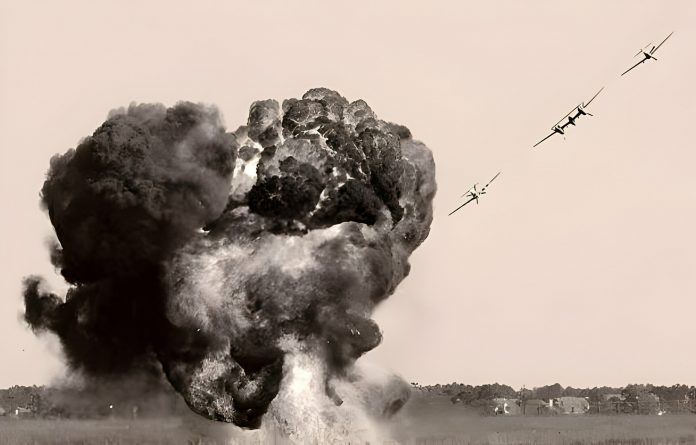The utilization of Vietnam War maps, depicting bomb concentrations and strategic military campaigns, provides a comprehensive insight into the conflict’s scale and impact. These maps highlight the disparities between North and South Vietnam, revealing the targeted disruptions of supply routes. In rural and border areas, airstrikes, documented on bomb maps, underscore the war’s effects on civilian populations and the environment. Additionally, these maps are crucial for identifying unexploded ordnance, posing long-term risks. Thus, Vietnam War maps serve as essential tools for understanding the multi-dimensional impacts of the conflict on both people and the landscape.

Vietnam
From 1965 to 1973, the U.S. military dropped over 7.5 million tons of bombs on Vietnam, Laos, and Cambodia. This was three times the total amount of bombs used by the Allied forces during World War II.
During the period of direct involvement in the Vietnam War until the signing of the Paris Agreement in 1973, the United States dropped a total of 4 million tons of bombs on both North and South Vietnam, with 840,000 tons on the North and 3.2 million tons on the South, four times more on the South than the North. The conflict truly concluded after the U.S. faced defeat in the Linebacker II campaign, often referred to as the “Dien Bien Phu in the air” victory in Vietnam.

In addition to conventional bombs, the U.S. military also employed Agent Orange, a toxic chemical. The first use of chemical warfare in Vietnam by the U.S. was on August 10, 1961. Over ten years (1961-1971), the U.S. conducted 19,905 sorties, spraying 80 million liters of chemical toxins, 61% of which was Agent Orange, containing 366 kg of dioxin over 26,000 villages, covering an area of 3.06 million hectares, nearly a quarter of South Vietnam’s total area. Of this, 44 million liters were Agent Orange/dioxin types 2,4D and 2,4,5-T; 86% of the area was sprayed more than twice, and 11% more than ten times.
Quang Tri province, situated in central Vietnam, gained notoriety during the Vietnam War as one of the most heavily bombed areas. Its strategic location between North and South Vietnam made it a focal point for large-scale military operations and airstrikes by the U.S. and its allies. The extensive bombing campaigns had profound effects on the province, leaving a lasting impact on the lives of its residents and the natural landscape. Today, Quang Tri bears the scars of its wartime history, serving as a poignant reminder of the devastating consequences of conflict in this region. The most famous and painful of which is Second Battle of Quang Tri.

Vietnam war map in the Kingdom of Laos
To destroy the Ho Chi Minh trail and cut off support from North to South Vietnam, as well as to aid the Royal Lao Government and the CIA-recruited and trained Vang Pao forces (including the participation of the Thai military in the Battle of Chum Field in 1971-1972) against the Pathet Lao and North Vietnamese forces in Laos, the U.S. conducted extensive bombing.

From 1964 to 1973, the U.S. carried out 580,000 aerial bombing missions, dropping over 2 million tons of bombs and explosives on Laos, averaging a bombing mission every 8 minutes, 24 hours a day, for over 9 years. In 1969 alone, the amount of bombs dropped on Laos exceeded that dropped on Japan during the entirety of World War II. Approximately 200,000 Laotians, mostly civilians, died, accounting for one-tenth of the country’s population.
Since the end of the Vietnam War in 1975, about 20,000 Laotians have been killed or injured by unexploded ordnance. An estimated one-third of the 2.5 million tons of bombs dropped across most of Laos’ 17 provinces, primarily in rural areas along the Vietnam border, did not explode.
Laos holds the record for the highest per capita rate of bombing in human history.

Kingdom of Cambodia
Similar to Laos, Cambodia, after declaring neutrality in 1954 following the Geneva Accords, allowed North Vietnam to use the Sihanoukville port for receiving and distributing Soviet and Eastern European aid. This was one of the reasons for the assassination attempts on King Sihanouk by the South Vietnamese political research office led by Ngo Dinh Nhu and Tran Kim Tuyen (involving Major General of Intelligence Dang Tran Duc).
During the secret Menu Campaign from March 1969 to May 1970, the U.S. Air Force conducted 3,630 B52 missions to Cambodia, dropping about 110,000 tons of bombs. This operation was kept secret from the U.S. Congress and public.
The U.S. and South Vietnam began openly intervening in Cambodia in April 1970 after Prime Minister Lon Nol and Prince Rajavong Sisowath Sirik Matak overthrew King Sihanouk, who was abroad (Lon Nol then established the pro-U.S. Khmer Republic, the origin of the anti-Vietnamese “Khmer Rouge” sentiment). From 1969 to 1973, the U.S. military conducted 227,000 airstrikes, dropping 539,000 tons of bombs and explosives on Cambodia, resulting in the deaths of about 150,000 to 200,000 Cambodians, with about a third of the rural civilian population killed.
U.S. and Allied bombing interventions in Cambodia significantly contributed to the rise of the Khmer Rouge.
